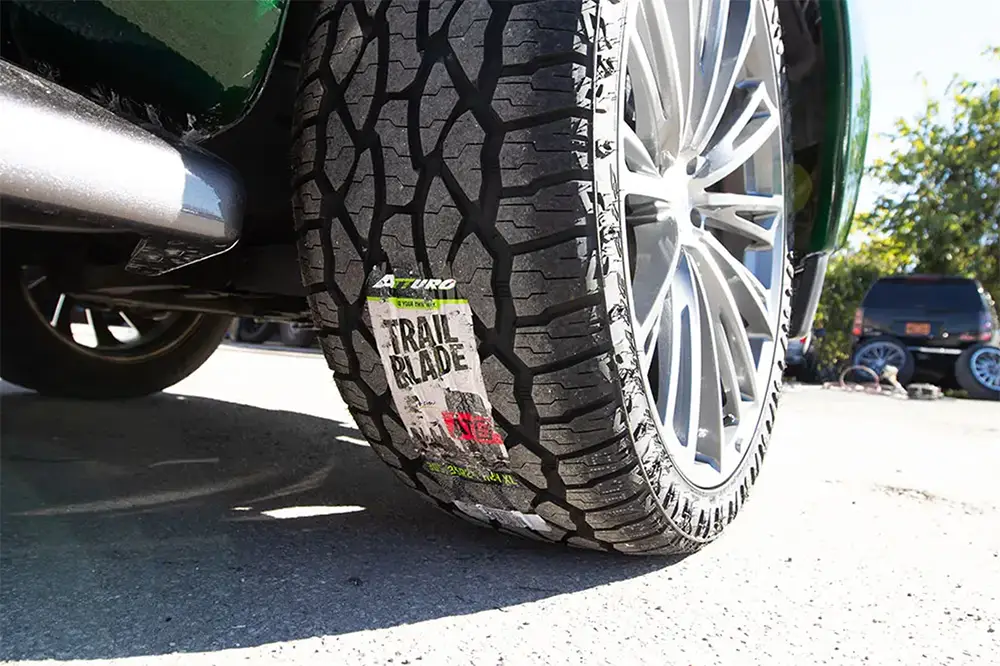 STREET TRUCKS STAFF
.
April 03, 2025
.
Industry News
.
STREET TRUCKS STAFF
.
April 03, 2025
.
Industry News
.

A vehicle’s tires determine its performance in various driving conditions. This is even more true for trucks, which cover long distances, carry heavy loads, and encounter diverse terrains. This article presents the best tires for street trucks.
Unlike usual trucks and pickups meant to explore off-road and heavy-duty tasks, street trucks are primarily modified for on-road performance and style. Hence, the question of which tires are best suited to these modifications also arises. Whether you drive a lowered Chevy Silverado, a bagged C10, or a custom Ford F250 lifted, this guide by StreetTrucks will help you find the right fit for different street truck setups.
Street trucks are a subcategory of regular trucks and pickups. The primary difference lies in the customized modifications that prioritize on-road performance and emphasize the vehicle’s aesthetics. These modifications usually include suspension lowering, body kits for aesthetic improvements, widebody designs, custom wheels, and performance tires instead of traditional all-terrain or off-road options.
Some owners seek to optimize street trucks’ high-speed and drag-racing performance, while others only limit themselves to aesthetic adjustments. Either way, street truck drivers share the same goal of improving the vehicle’s stability and traction, particularly on paved roads.
Some examples of street trucks include slammed Chevy Silverados, lowered S10s, bagged C10s, or OBS Chevys – all popular models in the custom street truck scene.
While off-road and all-terrain tires are standard options for common trucks, street trucks require specific tire characteristics. These vehicles come in modified builds like widebody, slammed, lifted, or bagged. They undergo modifications to perform predominantly on paved roads. As such, tires suitable for a street truck must prioritize responsive steering, agile handling, and enhanced grip on smooth surfaces rather than off-road traction.
Rugged, off-road tires are not an option for street trucks, as these vehicles don’t cover aggressive and uneven terrain. Performance tires are a better fit for street trucks whose horsepower builds require solid performance, like the black C10 custom or the 454 SS truck.
Meanwhile, all-season tires can also be an option for more classic models like the OBS Chevy and 1966 Chevy Trucks. Classic street truck variations usually prioritize comfort, and all-seasons are exactly what they need to match their specifications.
Low-profile tires are among the best options for a lowered C10, slammed S10, or custom-painted truck. Yet, despite the enhanced aesthetic, the trade-off could be a stiffer ride.
Lastly, lifted street trucks pair well with highway terrain tires. This type of tire lasts a long time and is notable for its increased stability, which would be a perfect fit for a 2005 Chevy Silverado 2500 lifted or a K5 Blazer.
The suspension of a lowered street truck sits lower to the ground. This allows for better handling, improved aerodynamics, and – obviously – more appealing aesthetics. Such modifications pair well with low-profile tires that add grip to the adjusted suspension, aiding cornering and reducing body roll. An additional benefit of these tires is their aesthetic contribution to the aggressive stance of a lowered Chevy SS clone, slammed Silverado, or a square body S10. So, here are some options to consider:
When choosing tires for a lowered street truck, remember that tire aspect ratio and width are essential criteria for grip and stance. Low-profile tires improve handling, but you can expect a comfort drop due to the stiff sidewalls.
Lifted trucks typically have increased ground clearance and a more aggressive stance. This allows for a commanding view of the road and enhanced performance.
Street trucks like lifted K5 Blazer, custom 2008 Chevy Silverado, and 1970 Ford F-150 pickups need larger tires to handle traction and ensure performance.
Yet, be careful with the tread pattern selection as it defines the fuel economy (the deeper the tread – the higher the rolling resistance). Still, lifted trucks that remain on paved roads don’t need tires with off-road-typical design. Instead, consider the following options:
Classic and patina trucks usually have aesthetic elements that emphasize their vintage look. Some tires fit this purpose while preserving the authenticity of vintage builds like the 1955 Chevy Truck, 1962 Ford F100, and 1958 Chevy Apache without sacrificing performance. Here are some options:
Remember to choose the proper wheel size to maintain a clean stance and ensure clearance.
As street trucks undergo various aesthetic and suspension modifications, tire selection requires careful consideration. It is a good practice to carefully evaluate factors such as tire performance ratings, size, and durability. More than that, ensuring the correct fitment is crucial in suspension modifications, whether you convert a Silverado to an Escalade or a slammed Ford Ranger.
Regardless of how you optimize your street truck, tire care, and maintenance remain essential for maximizing its performance. Proper pressure and timely rotation are just as necessary as in any other type of vehicle. Tires must match the truck’s weight and speed at which you intend to drive them. Last but not least, periodic alignment is essential, especially when lifting or lowering your truck is part of your customization.
Knowing the specifics of your build and setup is essential to choosing the right tires for your street truck. Additionally, it’s advisable to consider personal performance needs to choose the best match. Either way, the right tires will add value and tenacity to your modified street truck if you choose them wisely and keep your truck stance, weight, performance potential, and aesthetics in mind. Drive safe!
Share Link